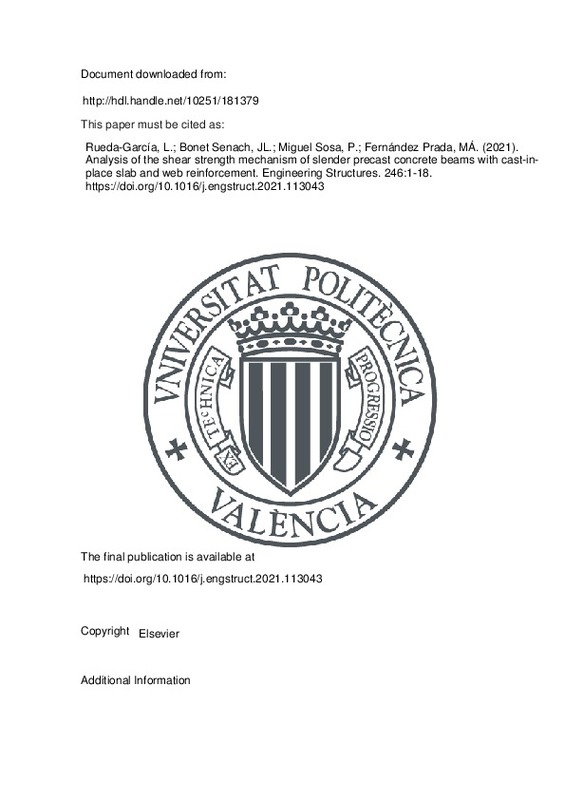JavaScript is disabled for your browser. Some features of this site may not work without it.
Buscar en RiuNet
Listar
Mi cuenta
Estadísticas
Ayuda RiuNet
Admin. UPV
Analysis of the shear strength mechanism of slender precast concrete beams with cast-in-place slab and web reinforcement
Mostrar el registro sencillo del ítem
Ficheros en el ítem
| dc.contributor.author | Rueda-García, Lisbel
|
es_ES |
| dc.contributor.author | Bonet Senach, José Luís
|
es_ES |
| dc.contributor.author | Miguel Sosa, Pedro
|
es_ES |
| dc.contributor.author | Fernández Prada, Miguel Ángel
|
es_ES |
| dc.date.accessioned | 2022-03-10T19:04:41Z | |
| dc.date.available | 2022-03-10T19:04:41Z | |
| dc.date.issued | 2021-11-01 | es_ES |
| dc.identifier.issn | 0141-0296 | es_ES |
| dc.identifier.uri | http://hdl.handle.net/10251/181379 | |
| dc.description.abstract | [EN] Precast concrete beams with cast-in-place slabs on top, namely concrete composite beams are frequently used for building concrete bridge decks. In designs, the contribution of cast-in-place slabs to shear strength tends to be omitted. However, given the vast number of existent bridges with this deck typology, significant cost savings could be made when assessing these structures if the slab's shear strength is considered. This paper analyses how cast-in-place slab influences the shear behaviour of concrete composite beams with web reinforcement. For this purpose, an experimental programme of 18 concrete specimens with web reinforcement and rectangular crosssections was run, in which the following parameters varied: cross-sectional depth; existence of an interface between concretes; compressive strengths of the concrete of beams and slabs; differential shrinkage between concretes. It was observed that: the slab contributed to resist shear; the existence of an interface between concretes led to a crack appearing along it that caused the transmitted shear to be divided into two load paths: one through the precast beam and another one through the slab; the slab's concrete strength was that which mainly influenced the element's shear strength; differential shrinkage did not reduce shear strength. Based on experimental observations, a mechanical model is proposed in this paper to assess the composite elements' shear strength, which considers the yielding of both stirrups and the slab's longitudinal reinforcement to be a failure criterion, which well predicted the experimental results. The shear formulations of Eurocode 2, the Level III Approximation of Model Code 2010 and the (b) Formula of ACI 318-19 offered a similar result to the herein proposed method when using the entire composite element effective depth and the weighted average of the concrete strengths of both the beam and slab estimated from the area ratio. Codes significantly underestimated specimens' interface shear. | es_ES |
| dc.description.sponsorship | The experimental programme of this research work was undertaken at the Concrete Science and Technology University Institute (ICITECH) of the Universitat Politecnica de Valencia (UPV; Spain) with concrete supplied by Caplansa. The project was supported by the Spanish Min-istry of Science and Innovation through Projects BIA2015-64672-C4-4-R and RTI2018-099091-B-C21-AR; the Regional Government of Valencia through Project AICO/2018/250; the European Union with FEDER funds. The authors thank the Spanish Ministry of Economy and Business for Grant BES-2016-078010 that supported Lisbel Rueda-Garcia. | es_ES |
| dc.language | Inglés | es_ES |
| dc.publisher | Elsevier | es_ES |
| dc.relation.ispartof | Engineering Structures | es_ES |
| dc.rights | Reconocimiento - No comercial - Sin obra derivada (by-nc-nd) | es_ES |
| dc.subject | Precast construction | es_ES |
| dc.subject | Reinforced concrete | es_ES |
| dc.subject | Composite beam | es_ES |
| dc.subject | Shear strength | es_ES |
| dc.subject | Shear failure | es_ES |
| dc.subject | Mechanical model | es_ES |
| dc.subject | Design | es_ES |
| dc.subject | Assessment | es_ES |
| dc.title | Analysis of the shear strength mechanism of slender precast concrete beams with cast-in-place slab and web reinforcement | es_ES |
| dc.type | Artículo | es_ES |
| dc.identifier.doi | 10.1016/j.engstruct.2021.113043 | es_ES |
| dc.relation.projectID | info:eu-repo/grantAgreement/AEI/Plan Estatal de Investigación Científica y Técnica y de Innovación 2017-2020/RTI2018-099091-B-C21/ES/MEJORA DE LA SOSTENIBILIDAD, SEGURIDAD Y RESILIENCIA DE LA CONEXION ENTRE VIGAS SEGMENTADAS PREFABRICADAS DE HORMIGON MEDIANTE EL USO DE NUEVOS MATERIALES./ | es_ES |
| dc.relation.projectID | info:eu-repo/grantAgreement/AEI//BES-2016-078010//AYUDAS PARA CONTRATOS PREDOCTORALES PARA LA FORMACION DE DOCTORES-RUEDA GARCIA/ | es_ES |
| dc.relation.projectID | info:eu-repo/grantAgreement/MINECO//BIA2015-64672-C4-4-R/ES/EVALUACION EXPERIMENTAL DE VIGAS CONTINUAS PRETENSADAS, CON Y SIN REFUERZO, Y PIEZAS COMPUESTAS DE DOS HORMIGONES, PARA LA EXTENSION DE SU VIDA UTIL./ | es_ES |
| dc.relation.projectID | info:eu-repo/grantAgreement/GENERALITAT VALENCIANA//AICO%2F2018%2F250//EVALUACION DE LA SEGURIDAD ESTRUCTURAL FRENTE A ESFUERZOS TANGENCIALES DE VIGAS COMPUESTAS DE HORMIGON./ | es_ES |
| dc.rights.accessRights | Abierto | es_ES |
| dc.description.bibliographicCitation | Rueda-García, L.; Bonet Senach, JL.; Miguel Sosa, P.; Fernández Prada, MÁ. (2021). Analysis of the shear strength mechanism of slender precast concrete beams with cast-in-place slab and web reinforcement. Engineering Structures. 246:1-18. https://doi.org/10.1016/j.engstruct.2021.113043 | es_ES |
| dc.description.accrualMethod | S | es_ES |
| dc.relation.publisherversion | https://doi.org/10.1016/j.engstruct.2021.113043 | es_ES |
| dc.description.upvformatpinicio | 1 | es_ES |
| dc.description.upvformatpfin | 18 | es_ES |
| dc.type.version | info:eu-repo/semantics/publishedVersion | es_ES |
| dc.description.volume | 246 | es_ES |
| dc.relation.pasarela | S\447178 | es_ES |
| dc.contributor.funder | GENERALITAT VALENCIANA | es_ES |
| dc.contributor.funder | AGENCIA ESTATAL DE INVESTIGACION | es_ES |
| dc.contributor.funder | MINISTERIO DE ECONOMIA Y EMPRESA | es_ES |
| dc.contributor.funder | European Regional Development Fund | es_ES |







![[Cerrado]](/themes/UPV/images/candado.png)

